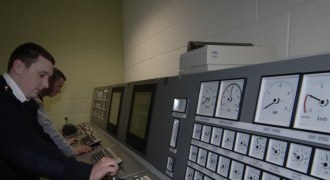Engineering Branch Cadet
The Engineering Branch Cadet will be trained to a level whereby he/she can fill an appointment as a ships’ Marine Engineering Officer. The Engineering Officer is responsible for everything that keeps a ship afloat, moving and habitable. This includes the hull and general structures of the ship, its main engines and all auxiliary machinery, the main electrical generators, the electrical distribution system, the air conditioning, ventilation, heating systems and cold rooms as well as all fuel and water systems. It also includes the computer systems for communications, navigation and weapons control systems.
Check http://www.military.ie/careers/cadetships.htm for information on Officer Entry into the Defence Forces.
Engineering Branch Cadets in the Naval Service undergo a course of training of approximately two years duration before being commissioned on a 3 year Short Service Commission in the rank of Ensign/Sub-Lieutenant in accordance with paragraph 18 below. The training course of the Cadet and Young Officer is physically and academically demanding and requires total dedication and commitment in order to be successful.
When fully qualified an Officer will, subject to satisfying certain criteria and on being recommended by the Flag Officer Commanding the Naval Service and the Chief of Staff, then be offered a full Commission without limitation as to time.
Initial training involves Basic Military and Naval Training at the Cadet School, Military College, DFTC, Curragh Camp and later at the Naval Base, Haulbowline, Co Cork and onboard ship. The initial training is similar to, and shared with, Operations Branch Cadets. In the second year the Cadet will commence studies at the National Maritime College Ireland (NMCI) for award of a Degree in Marine Engineering.
After commissioning, training continues both at sea and ashore until the Officer is fully qualified to take up an appointment as a Marine Engineer Officer onboard ship.
The fully trained Junior Officer spends the following two years on sea/shore rotations. When at sea, he/she will be appointed as the Engineer Officer, while shore duties involve training or technical/administrative appointments. The Engineer Officer can avail of opportunities of further education as well as participating in a range of specialist courses applicable to the Marine Engineering profession at home or abroad.

